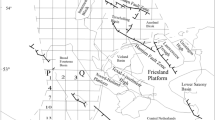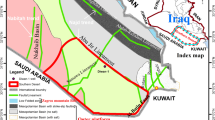Abstract
In this study, we apply Tikhonov’s regularization algorithm for a 3-D density inversion from the gravity-gradiometry data. To reduce the non-uniqueness of the inverse solution (carried out without additional information from geological evidence), we implement the depth-weighting empirical function. However, the application of an empirical function in the inversion equation brings the bias problem of the regularization factor when a traditional Tikhonov’s algorithm is applied. To solve the bias problem of regularization factor selection, we present a standardized solution that comprises two parts for solving a 3-D constrained inversion equation, specifically the linear matrix transformation and Tikhonov’s regularization algorithm. Since traditional regularization techniques become numerically inefficient when dealing with large number of data, we further apply methods which include the Simultaneous Iterative Reconstruction Technique (SIRT) and the wavelet compression combined with Least Squares QR-decomposition (LSQR). In our simulation study, we demonstrate that SIRT as well as the wavelet compression plus LSQR algorithm improve the computation efficiency, while provide results which closely agree with that obtained from applying Tikhonov’s regularization. In particular, the algorithm of wavelet compression plus LSQR shows the best computing efficiency, because it combines the advantages of coefficients compression of big matrix and fast solution of sparse matrix. Similar findings are confirmed from the vertical gravity gradient data inversion for detecting potential deposits at the Kauring (near Perth, Western Australia) testing site.
Similar content being viewed by others
References
Christensen A., 2013. Results from FALCON® Airborne Gravity Gradiometer surveys over the Kauring AGG test site. ASEG Extended Abstracts 2013: 23rd Geophysical Conference, DOI: 10.1071/ASEG2013ab300.
Commer M., 2011. Three-dimensional gravity modelling and focusing inversion using rectangular meshes. Geophys. Prospect., 59, 966–979.
Davis K. and Li Y., 2011. Fast solution of geophysical inversion using adaptive mesh, space-filling curves and wavelet compression. Geophys. J. Int., 185, 157–166.
DiFrancesco D., 2013. The coming of age of gravity gradiometry. ASEG Extended Abstracts 2013: 23rd Geophysical Conference, DOI: 10.1071/ASEG2013ab062.
DiFrancesco D., Meyer T., Christensen A. and Fitzgerald D., 2009. Gravity gradiometry-today and tomorrow. 11th SAGA Biennial Technical Meeting and Exhibition, Swaziland, 16–18 September 2009, 80–83.
Dransfield M., 2007. Airborne gravity gradiometry in the search for mineral deposits. In: Milkereit B. (Ed.), Proceedings of Exploration 07: Fifth Decennial International Conference on Mineral Exploration. Decennial Mineral Exploration Conferences, Toronto, Canada, 341–354.
Dransfield M. and Zeng Y., 2009. Airborne gravity gradiometry: Terrain corrections and elevation error. Geophysics, 74, I37–I42.
Droujinine A., Vasilevsky A. and Evans R., 2007. Feasibility of using full tensor gradient (FTG) data for detection of local lateral density contrasts during reservoir monitoring. Geophys. J. Int., 169, 795–820.
Eshagh M., 2011. Sequential Tikhonov regularization: an alternative way for inverting satellite gradiometric data. Zeitschrift fur Geodasie, Geoinformation und Landmanagement, 136(2), 113–121.
Fang S., Zhang X., Jia S., Duan Y., Yang Z. and Qiu S., 2003. Multi-scale decomposition of Bouguer gravity anomaly and seismic activity in north China. J. Geodesy Geodyn., 23(B12), 34–40.
Golub G.H., Heath M. and Wahba G., 1979. Generalized cross-validation as a method for choosing a good ridge parameter. Technometrics, 21, 215–223.
Hansen P.C., 1999. The L-Curve and its Use in the Numerical Treatment of Inverse Problems. IMM, Department of Mathematical Modelling, Technical Universityof Denmark, Lyngby, Denmark.
Hansen P.C. and Saxild-Hansen M., 2012. AIR tools: a MATLAB package of algebraic iterative reconstruction methods. J. Comput. Appl. Math., 236, 2167–2178.
Jekeli C. and Zhu L., 2006. Comparison of methods to model the gravitational gradients from topographic data bases. Geophys. J. Int., 166, 999–1014.
Kirkendall B., Li Y. and Oldenburg D., 2007. Imaging cargo containers using gravity gradiometry., IEEE Trans. Geosci. Remote Sens., 45, 1786–1797.
Lewis A.S. and Knowles G., 1992. Image compression using the 2-d wavelet transform. IEEE Trans. Image Process., 1, 244–250.
Li X., 2001. Vertical resolution: Gravity versus vertical gravity gradient. The Leading Edge, 20(8), 901–904.
Li Y. and Oldenburg D.W., 1998. 3-D inversion of gravity data. Geophysics, 63, 109–119.
Li Y. and Oldenburg D.W., 2003. Fast inversion of large-scale magnetic data using wavelet transforms and a logarithmic barrier method. Geophys. J. Int., 152, 251–265.
Li Y. and Yang Y., 2011. Gravity data inversion for the lithospheric density structure beneath North China Craton from EGM 2008 model. Phys. Earth Planet. Inter., 189, 9–26.
Liu J., 2014. Airborne Gravity Gradient Tensor Data Forward Modeling and Inversion Application. Ph.D. Thesis. University of Chinese Academy of Sciences, Beijing, China.
Liu Y.P., Wang Z.W., Du X.J., Liu J.H. and Xu J.S., 2013. 3D constrained inversion of gravity data based on the Extrapolation Tikhonov regularization algorithm. Chinese J. Geophys., 56(5), 1650–1659, DOI: 10.6038/cjg20130522 (in Chinese).
Martin R., Monteiller V., Komatitsch D., Perrouty S., Jessell M., Bonvalot S. and Lindsay M., 2013. Gravity inversion using wavelet-based compression on parallel hybrid CPU/GPU systems: application to southwest Ghana. Geophys. J. Int., 195, 1594–1619.
Martinez C. and Li Y., 2012. Understanding gravity gradiometry processing and interpretation through the kauring test site data. ASEG Extended Abstracts 2012: 22nd Geophysical Conference, DOI: 10.1071/ASEG2012ab238.
Meyer C.D., 2000. Matrix Analysis and Applied Linear Algebra. SIAM: Society for Industrial and Applied Mathematics, Philadeplphia, PA.
Murphy C.A., 2010. Recent developments with Air-FTG®. In: Lane R.J. (Ed.), Airborne Gravity 2010. Abstracts from the ASEG-PESA Airborne Gravity 2010 Workshop: Published jointly by Geoscience Australia and the Geological Survey of New South Wales, Geoscience Australia Record 2010/23 and GSNSW File GS2010/0457, 142–151.
Murphy C.A. and Dickinson J.L., 2009. Exploring exploration play models with FTG gravity data, 11th SAGA Biennial Technical Meeting and Exhibition, Swaziland, 16–18 September 2009, 89–91.
Paige C.C. and Saunders M.A., 1982a. Algorithm 583: LSQR: Sparse linear equations and least squares problems. ACM Trans. Math. Softw. (TOMS), 8(2), 195–209.
Paige C.C. and Saunders M.A., 1982b. LSQR: An algorithm for sparse linear equations and sparse least squares. ACM Trans. Math. Softw. (TOMS), 8(1), 43–71.
Portniaguine O. and Zhdanov M.S., 1999. Focusing geophysical inversion images. Geophysics, 64, 874–887.
Silva J.B. and Barbosa V.C., 2003. 3D Euler deconvolution: Theoretical basis for automatically selecting good solutions. Geophysics, 68, 1962–1968.
Snieder R. and Trampert J., 1999. Inverse problems in geophysics. In: Wirgin A. (Ed.), Wavefield Inversion. Springer-Verlag, Wien, Austria.
Su B., Zhang Y., Peng L., Yao D. and Zhang B., 2000. Simultaneous iterative reconstruction technique for electrical capacitance tomography. J. Tsinghua Univ. Sci. Technol., 40(9), 90–92.
Tikhonov A.N. and Arsenin V.Y., 1977. Solutions of Ill-Posed Problems. V.H. Winston & Sons, Washington, D.C.
Wang H., Chen C. and Du J., 2013. Three-dimensional inversion methods and applications of the gravity gradient tensor data. Oil Geophys. Prospect., 48(3), 474–481 (in Chinese).
Wild F. and Heck B., 2005. A comparison of different isostatic models applied to satellite gravity gradiometry. In: Jekeli C., Bastos L. and Fernandes J. (Eds), Gravity, Geoid and Space Missions. International Association of Geodesy Symposia 129, Springer-Verlag, Heidelberg, Germany, 230–235.
Zhang C., Mushayandebvu M.F., Reid A.B., Fairhead J.D. and Odegard M.E., 2000. Euler deconvolution of gravity tensor gradient data. Geophysics, 65, 512–520.
Zhdanov M.S., Ellis R. and Mukherjee S., 2004. Three-dimensional regularized focusing inversion of gravity gradient tensor component data. Geophysics, 69, 925–937.
Author information
Authors and Affiliations
Corresponding author
Rights and permissions
About this article
Cite this article
Ye, Z., Tenzer, R. & Sneeuw, N. Comparison of methods for a 3-D density inversion from airborne gravity gradiometry. Stud Geophys Geod 62, 1–16 (2018). https://doi.org/10.1007/s11200-016-0492-6
Received:
Revised:
Accepted:
Published:
Issue Date:
DOI: https://doi.org/10.1007/s11200-016-0492-6




